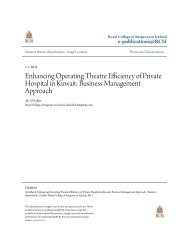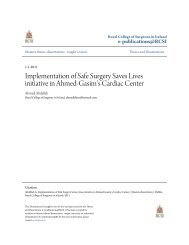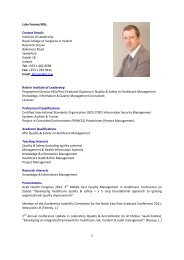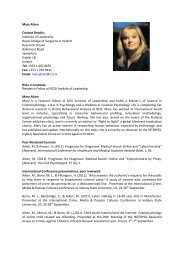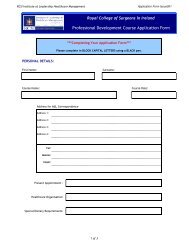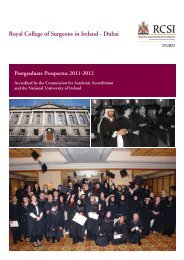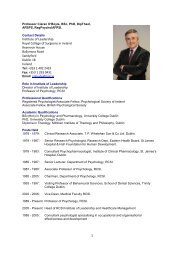Improving the Assessment and Triage of Patients with Mental Illness ...
Improving the Assessment and Triage of Patients with Mental Illness ...
Improving the Assessment and Triage of Patients with Mental Illness ...
You also want an ePaper? Increase the reach of your titles
YUMPU automatically turns print PDFs into web optimized ePapers that Google loves.
The observational audit carried out in triage pre <strong>the</strong> implementation noted that<br />
patients triaged using <strong>the</strong> <strong>Mental</strong> <strong>Illness</strong> <strong>Triage</strong> Tool were given a higher triage category<br />
(Appendix Q) than those triaged using <strong>the</strong> Manchester <strong>Triage</strong> Scale. Finally triage times were<br />
reduced from six minutes to four minutes. This reduction according to staff was related to <strong>the</strong><br />
computerised pop-up screen<br />
While staff almost unanimously agreed that <strong>the</strong> computerised pop-up screen <strong>and</strong> <strong>the</strong><br />
triage tool were <strong>of</strong> benefit to <strong>the</strong> department, <strong>the</strong> nursing assessment document was not<br />
greeted <strong>with</strong> <strong>the</strong> same level <strong>of</strong> enthusiasm. The design was not <strong>the</strong> issue; <strong>the</strong> fact was that<br />
nursing staff considered that <strong>the</strong>re were too many nursing documents to manage. It was<br />
suggested that <strong>the</strong> design should be amalgamated <strong>with</strong> <strong>the</strong> original document.<br />
Despite not accomplishing all <strong>the</strong> elements outlined in <strong>the</strong> Project Impact statement it<br />
was considered that <strong>the</strong> change management project was ultimately a success. Those<br />
elements not achieved are currently being considered by management (such as <strong>the</strong> contacting<br />
<strong>of</strong> psychiatry direct from triage <strong>and</strong> <strong>the</strong> retention <strong>of</strong> a mental health nurse practitioner) <strong>and</strong><br />
negotiations are in progress <strong>with</strong> <strong>the</strong> relevant authorities.<br />
4.3 Conclusion<br />
The results <strong>of</strong> <strong>the</strong> questionnaires, focus group <strong>and</strong> interviews have provided<br />
considerable information on <strong>the</strong> benefits <strong>of</strong> <strong>the</strong> change project. Based on <strong>the</strong> findings it can<br />
be concluded that; <strong>the</strong> use <strong>of</strong> a well structured triage tool can benefit <strong>the</strong> assessment <strong>of</strong> <strong>the</strong><br />
patient <strong>and</strong> significantly increase staff confidence by providing guidance in relation to <strong>the</strong><br />
patient’s presentation. The development <strong>of</strong> a triage screen that requires only a “yes” or “no”<br />
response while still ga<strong>the</strong>ring significant information on <strong>the</strong> patient helps to cut down on<br />
triage times. These initiatives have led to improvements for patients <strong>and</strong> staff highlighting<br />
that although a project may be small it can have huge implications <strong>and</strong> benefits.<br />
The next chapter discusses <strong>the</strong> strengths <strong>and</strong> limitations <strong>of</strong> <strong>the</strong> project <strong>and</strong> also<br />
recommendations for <strong>the</strong> future.<br />
35




